Physical Address
304 North Cardinal St.
Dorchester Center, MA 02124
Tendons transmit forces generated by muscles to move joints or to create action power. Flexor tendon injuries are common, but recovery of satisfactory function, particularly after injuries within the digital sheath, is sometimes difficult. Lacerated flexor tendons should be treated by primary surgical repair whenever possible.
The current trend of end-to-end surgical tendon repairs is to use multistrand core sutures (four-strand repairs such as cruciate, double-Tsuge, Strickland, and modified Savage, or six-strand repairs such as modified Savage and Tang).
In tendon repairs in the digital sheath area, a number of surgeons advocate that the A2 pulley can be released up to two-thirds of its length, the A4 pulley can be entirely released when necessary, and tendon repair is in the proximity of the pulley, given the integrity of the other pulleys. The release may reduce the resistance to tendon motion and the chance of repair ruptures. This technique is somewhat controversial.
Postoperatively, early tendon mobilization should always be employed, except in children or in some rare instances; motion protocols vary greatly among different treatment centers.
Repair ruptures, adhesion formations, and finger joint stiffness are major complications of primary surgery.
Combined use of multistrand core repairs, release of constricting pulley parts, and well-designed postoperative combined passive and active motion protocols – that do not overload, but sufficiently move the tendon – can help minimize adhesions, avoid repair ruptures, and restore optimal function.
Secondary surgeries include tenolysis, free tendon grafting, and staged tendon reconstruction. Tenolysis is indicated when restricting adhesions hamper tendon gliding and soft tissues and joint conditions of the hand are favorable. Free tendon grafting is a salvage operation for failed primary repairs, delayed treatment (>1 month) of an acute cut, or lengthy tendon defects. Staged reconstruction is indicated in cases of extensive scar formation or multiple failed surgeries. Preservation or reconstruction of major annular pulleys is vital to restoring function of the digits during these secondary surgeries.
Closed ruptures of flexor tendons usually require surgical repairs.
The success of flexor tendon surgeries is very expertise dependent. A thorough mastery of anatomy and meticulous surgical techniques are requirements for satisfactory restoration of function.
Tendons are composed of dense connective tissues that transmit forces generated by muscles to move the joints or to create action power. Functionally, the hand is dependent upon the integrity and ample gliding of the tendons.
Difficulties in restoration of function of digital flexor tendons relate chiefly to the intricate anatomy of flexor tendon systems: the coexistence of superficialis and profundus tendons within a tight fibro-osseous tunnel.
( Box 24.1 )
Repairing flexor tendons requires meticulous surgery built upon a thorough mastery of anatomy and biomechanics of the flexor tendon system. Surgeons should know the anatomy in detail, including the length of major pulleys, characteristic changes in the diameter of the sheath, and tendon gliding amplitude.
Primary repairs should be performed by experienced surgeons whenever possible, or if a less experienced surgeon has to be the operator, before surgery, the surgeon must review the anatomy of the flexor tendon system and understand every detail of the requirements of an optimal tendon repair.
The mastery of atraumatic techniques is essential for the operator. The outcome of the repair is very expertise dependent: repair of tendons by an inexperienced surgeon is a frequent cause of tendon adhesions and poor function; thus, it should be avoided.
Conventional two-strand repairs are weak; stronger surgical repairs are preferable.
Complete closure of the tendon sheath is not a necessity. Venting of a part of sheath (<2.0 cm), including a critical portion of the pulleys, provides easy access to injured tendons and may decrease resistance to tendon gliding after surgery; this procedure does not lead to loss of digital function when other sheath parts are intact.
Surgeons should emphasize strengthening suture techniques and decreasing compression to the tendons, which facilitate increases in safety and expertise in hand therapy.
Whenever possible, acutely lacerated flexor tendons in the hand and forearm should be treated primarily or at the delayed primary stage.
Primary tendon repair is the end-to-end repair performed immediately after wound cleaning and debridement, usually within 24 h of trauma.
Delayed primary repair is defined as repair performed within 3 or even 4 weeks after tendon lacerations.
The tendon injured in critical areas (such as zone 2) should not be repaired by an inexperienced surgeon. Rather, tendon repair can be delayed until an experienced surgeon is available.
My preferred period of deliberate delay is 4–7 days, when the risk of infection can be properly addressed and edema has reduced substantially.
Delay of the repair beyond 3–4 weeks may cause myostatic shortening of the muscle–tendon unit; for these late cases, lengthening the tendon within the muscles in the forearm can ease the tension ( Fig. 24.1 ) .
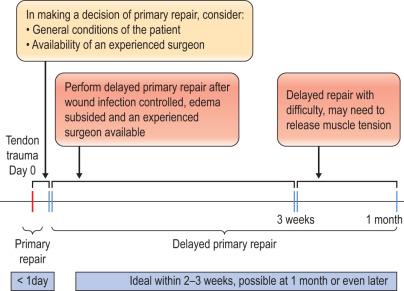
Rupture of the repaired flexor tendons after surgery can be re-repaired if the rupture occurs within a few weeks up to a month after surgery; secondary tendon grafts may be the only choice for ruptured cases in the presence of obvious retraction of the tendon end or extensive scarring in the intact flexor digitorum superficialis (FDS) tendon when the flexor digitorum profundus (FDP) tendon ruptures.
Traumatic FDP tendon avulsion from the tendon–bone junction accounts for a major portion of closed rupture cases. The tendon disrupts at its insertion to the distal phalanx.
The injury mechanism is hyperextension of the distal interphalangeal (DIP) joint, which subjects the FDP tendon to excessive load.
Athletic injuries can lead to this type of injury. When one player grabs another's jersey, a finger may be caught and pulled, resulting in disruption of flexor tendons. This injury (“jersey finger”) is seen most commonly in the ring finger.
Closed tendon ruptures at the wrist can be associated with fractures in carpal bones.
Flexor pulleys are prone to sprains and ruptures during climbing. Rupture of the pulleys occurs in up to 20% of climbers. The A2 pulley of the ring finger is the most often injured. Closed pulley ruptures are treated conservatively or by surgical reconstruction.
Closed tendon ruptures can be classified into the following types:
Class I: the FDP tendon is avulsed from the phalanx and retracts into the palm. The vincula of the FDP tendon are disrupted. There is no active flexion of the DIP joint. A tender mass is present in the palm.
Class II: the FDP tendon retracts to the level of the proximal interphalangeal (PIP) joint. This is the most common type. The sheath is not compromised, and muscle contracture does not develop easily.
Class III: a large bone fragment is attached to the FDP tendon. This bone fragment frequently prevents the tendon from retracting proximal to the A4 pulley.
Class IV: the FDP tendon avulses from the bony fragment and retracts beyond the middle phalanx and even into the palm.
Early recognition of closed tendon ruptures is of paramount importance. In cases where there is late diagnosis, primary repair is difficult or even impossible. Chronic cases require free tendon grafting.
Tendon grafting is indicated: (1) when the lacerated tendons are not treated during primary or delayed primary stage; (2) when the primary repairs have ruptured and cannot be re-repaired directly; and (3) in the cases not indicative of primary tendon repairs because of severe contamination, infection, lengthy loss of tendon substance, extensive destruction of the pulleys, or accompanying injuries.
Flexor tendon injuries are open in most cases, resulting from a sharp cut or a crush, but they can also present as closed injuries.
Open injuries due to extensive trauma are frequently associated with neurovascular deficits.
Closed injuries often relate to forced extension during active flexion of the finger.
Flexor tendon rupture can also occur as a result of chronic attrition in rheumatoid disease, Kienbock disease, scaphoid nonunion, or hamate or distal radius fracture.
Careful attention to the patient's history and the mechanism of injury can alert the surgeon to the extent of the tendon trauma and associated injuries.
The natural resting posture of the wounded digits is important for evaluation.
Complete lacerations of both FDP and FDS tendons are easily diagnosed when the affected fingers are seen in a relatively extended position with loss of active finger flexion at PIP and DIP joints.
If the patient can actively flex the DIP joint while the motion of the PIP joint is blocked, no injuries or only partial injuries to the FDP tendon can be diagnosed.
To assess the continuity of the FDS tendon, the adjacent fingers are held in full extension by the examiner. If the patient cannot actively flex the PIP joint, the FDS tendon is completely severed.
Variations in the FDS tendons in the little finger are frequent. The FDS in 30–35% of the little fingers is connected with the FDS in the ring or middle fingers. Some little fingers (10–15%) are missing an FDS tendon. These patients have limited or no PIP flexion of the little finger during testing.
Weakness during resisted finger flexion indicates a possible partial tendon cut.
To test the FPL tendon, the thumb metacarpophalangeal joint (MCP) is stabilized in a neutral position. The patient is asked to flex the IP joint. Loss of active flexion at the joint indicates complete severance of the FPL tendon.
Nerve and vascular function should be assessed routinely because accompanying injuries in the neurovascular bundles in one or both sides of the fingers or median and ulnar nerves at the carpal tunnel or distal forearm are common.
Loss of sensation in the finger pulps or loss of function of intrinsic muscles in the hand is indicative of such accompanying injuries; treatment of neurovascular injuries must be included when planning surgical strategies.
If fingers or hands are found to be hypovascular or avascular due to vascular lacerations, vascular anastomosis should be a surgical emergency.
Otherwise, after wound debridement, either the lacerated flexor tendons can be repaired (when experienced surgeons are readily available), or the skin can be closed to allow for delayed primary repairs within days by experienced surgeons.
Radiographs should always be taken. Associated fractures are not infrequent and require treatment.
CT or MRI should be prescribed for the cases suspicious of closed tendon ruptures. Ultrasonographic examination may also reveal rupture of the tendons.
Primary or delayed primary end-to-end tendon repairs are mainly indicated in clean-cut tendon injuries with limited damage to peritendinous tissues.
Serious crush injuries, severe wound contamination, loss of extensive soft tissues, or extensive destruction of pulleys and tendon structures are contraindications for primary tendon repairs.
Fractures involving multiple bones, particularly at different levels or not yielding stable internal fixation, are contraindications for primary tendon repairs ( Box 24.2 ).
Clean-cut tendon injuries
Tendon cut with limited peritendinous damage, no defects in soft tissue coverage
Regional loss of soft tissue coverage or fractures of phalangeal shafts are borderline indications
Within several days or, at most, 3 or 4 weeks after tendon laceration
Severe wound contamination
Bony injuries involving joint components or extensive soft tissue loss
Destruction of a series of annular pulleys and lengthy tendon defects
Experienced surgeons are not available
Flexor tendon repairs in children have a better prognosis than those in adults. As children may be less compliant with instructions to limit movement, the repaired digits are usually immobilized for 3–3.5 weeks after surgery. Either a two-strand or a four-strand repair can be used.
There are 12 flexor tendons in the hand and forearm regions, including finger and thumb flexors and wrist flexors.
Finger flexor tendons are the FDS, FDP, and flexor pollicis longus (FPL).
The FDS and FDP originate from muscles at about the midforearm, while the FPL tendon arises from the volar aspect of the midportion of the radial shaft and from its adjacent interosseous membrane.
The tendons of the FDP come from a common muscle belly, while the tendons of the FDS originate from separate muscle bellies, which allows more independent finger flexion.
The wrist flexors are the flexor carpi radialis (FCR) and ulnaris, and the palmaris longus (PL).
The PL is absent in about 15–20% of the normal population, and wrist flexion power is not affected by its absence.
Within the carpal tunnel, nine tendons exist – four FDS, four FDP, and one FPL.
The relationship of these tendons within the carpal tunnel is fairly constant.
The FDS tendons to the ring and middle fingers lie superficially, deeper are the FDS tendon to the index and small fingers, and deeper still are the FDP tendons.
The FPL tendon is located deep and radially adjacent to the scaphoid and the trapezium.
After emerging from the carpal tunnel, the tendons enter the palm. At about the level of the superficial palmar artery arch, the lumbrical tendons originate from the FDP tendons.
The most intricate portions of the flexor tendons are within the fingers, where the tendons glide within a closed fibro-osseous sheath with segmental, semirigid, constrictive dense connective tissue bands present.
The digital sheath forms a closed synovial compartment extending from the distal palm to the middle of the distal phalange.
The FDS tendons lie superficial to the FDP tendons up to the bifurcation of the FDS tendon at the level of the MCP. There, in the A2 pulley area, the FDS tendons become two slips coursing laterally and then deeper to the FDP tendons.
Now deep to the FDP tendon, the FDS slips rejoin to form Camper chiasm (a fibrous interweaved connection between two FDS slips), and distally insert on the proximal and middle parts of the middle phalanx as two separate slips.
The FDP tendon inserts into the volar aspect of the distal phalanx.
The FPL tendon is the only tendon inside the flexor sheath of the thumb and inserts at the distal phalanx.
The synovial sheath is a thin layer of continuous smooth paratenon covering the inner surface of the fibrous sheath, providing a smooth surface for tendon gliding and nutrition to the tendons.
The pulley system of the digital flexor tendon is unique; it consists of annular pulleys (condensed, rigid, and heavier annular bands) and cruciate pulleys (filmy cruciform bands) ( Fig. 24.2 ) . The annular pulleys maintain the anatomical paths of tendons close to bones and phalangeal joints, thus optimizing the mechanical efficiency of digital flexion. The more compressible cruciate pulleys allow for digital flexion to occur with condensation of the fibro-osseous sheath at the inner part of flexed fingers.
There are five annular pulleys (A1–A5), three cruciate pulleys (C1–C3), and one palmar aponeurosis pulley.
The A1, A3, and A5 pulleys originate from the palmar plates of the MCP, PIP, and DIP joints, and the A2 and A4 pulleys originate from the middle portion of the proximal and middle phalanges, respectively.
The broadest annular pulley is the A2 pulley, which covers the proximal two-thirds of the proximal phalanx and encompasses the bifurcation of the FDS tendon at its middle part.
The A4 pulley is located at the middle third of the middle phalanx.
The A2 and A4 pulleys are the largest among five annular pulleys and have the most important function.
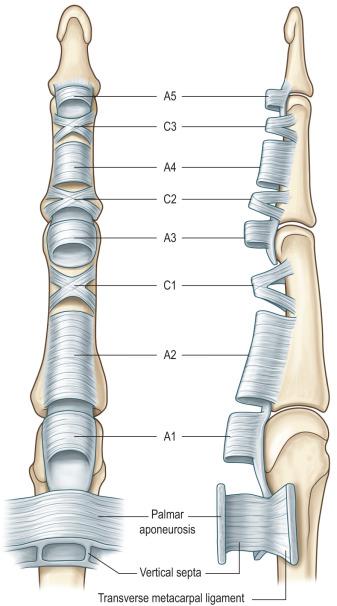
In the thumb, there are three pulleys (A1, oblique, and A2) with no cruciate pulleys ( Fig. 24.3 ) .
The A1 and oblique pulleys are functionally important.
The A1 pulley is located palmar to the MCP joint, while the oblique pulley spans the middle and distal parts of the proximal phalanx.
The A2 pulley is near the site of insertion of the FPL tendon.
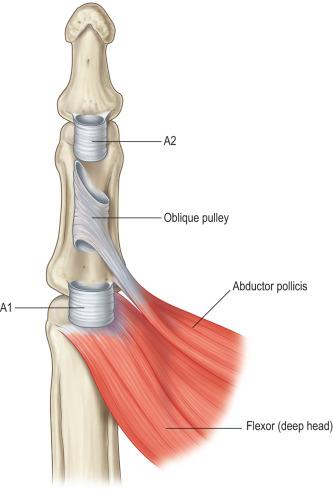
The FDP tendon has two vincula: a fanlike, short vinculum and a cordlike, long vinculum. The short vinculum is located at the insertion of the FDP tendon ( Fig. 24.4 ) . The long vinculum connects the FDP tendon through the short vinculum of the FDS tendon to the floor of the palmar surface of the phalanges.
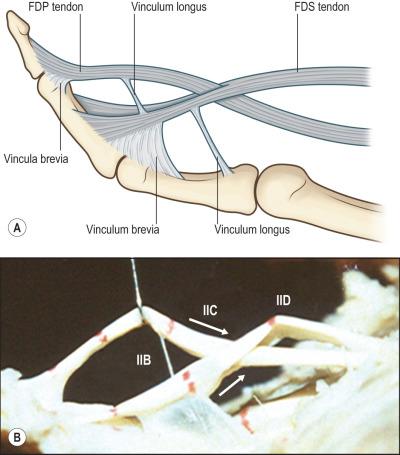
The FDS tendon also has two vincula: one connecting to the proximal phalanx and another at the insertion of the FDS tendon.
Vincula carry blood vessels to the dorsum of these tendons, providing limited nutrition. Tendon insertion sites to bones also carry vessels into tendons over a very short distance.
According to anatomical features, the flexor tendons in the hand and forearm are divided into five zones, which offer the fundamental nomenclature for flexor tendon anatomy and surgical repairs ( Figs. 24.5 , 24.6 ) :
Zone 1: from the insertion of the FDS tendon to the terminal insertion of the FDP tendon.
Zone 2: from the proximal reflection of the digital synovial sheath to the FDS insertion.
Zone 3: from the distal margin of the transverse carpal ligament to the digital synovial sheath.
Zone 4: area covered by the transverse carpal ligament.
Zone 5: proximal to the transverse carpal ligament.
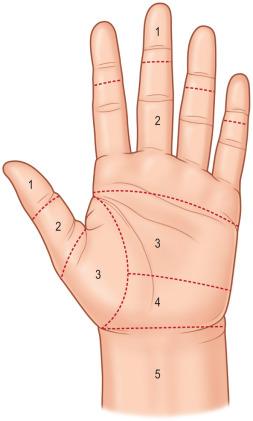
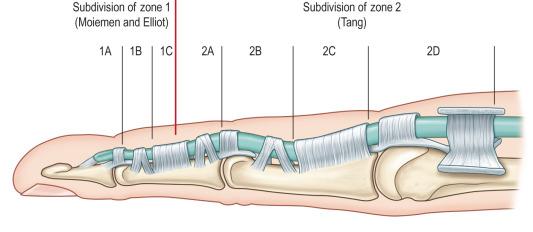
In the thumb, zone 1 is distal to the interphalangeal (IP) joint, zone 2 is from the IP joint to the A1 pulley, and zone 3 is the area of the thenar eminence.
Flexor tendons derive nutrition from both synovial and vascular sources. Tendons outside the synovial sheath are supplied with a segmental vascular network through paratenon; however, the tendons within the synovial sheath are mostly deprived of a vascular network with only limited dorsal regions around the vincular insertions being vascularized.
Intrasynovial flexor tendons can heal through two mechanisms – intrinsic and extrinsic.
Intrinsic healing takes place through the proliferation of tenocytes and production of extracellular matrix by intrinsic cells.
Intrinsic healing capacity is innately weak, and healing exclusively through this mechanism does not occur in vivo.
Extrinsic healing is through the growth of tissues or cells seeding from outside the tendon.
Extrinsic healing becomes dominant when intrinsic healing capacity is disabled (such as in the case of severe trauma to the tendon or peritendinous tissues) or under conditions (such as postsurgical immobilization) favoring extrinsic healing.
Extrinsic healing may act on the tendon healing process either by forming adhesions or seeding the extrinsic cells without adhesions to the laceration site.
Clinically, the lacerated tendon heals through a combination of both intrinsic and extrinsic mechanisms, whose balance depends upon the condition of the tendon and surrounding tissues.
The following five variants (grades) of adhesions and their effects on tendon motion are seen clinically:
No adhesions; no effect on motion.
Filmy adhesions: formation of visible, filmy, and membranous tissue from tendon to outside tissues; no effect on motion.
Loose adhesions: loose and largely movable; mildly affects motion.
Moderately dense adhesions: of limited mobility; dramatically affects motion.
Dense adhesions: dense, almost immovable, and invading deep into the tendon; dramatically affects motion.
The most effective methods to prevent adhesions in clinic are meticulous surgery and early postoperative motion; the prime cause of adhesions is tendon repair by inexperienced surgeons.
Many factors affect the strength of a surgical repair ( Fig. 24.7 ) : (1) the number of suture strands across the repair sites – strength is roughly proportional to the number of core sutures; (2) the tension of repairs – this is most relevant to gap formation and stiffness of repairs; (3) the core suture purchase; (4) the types of tendon–suture junction – locking or grasping; (5) the diameter of suture locks in the tendons – a small-diameter lock diminishes anchor power; (6) the suture caliber (diameter); (7) the material properties of suture materials; (8) the peripheral sutures; (9) the curvature of tendon gliding paths – the repair strength decreases as tendon curvature increases; and (10) above all, the holding capacity of a tendon, affected by varying degrees of trauma and posttraumatic tissue softening, plays a vital role in repair strength.
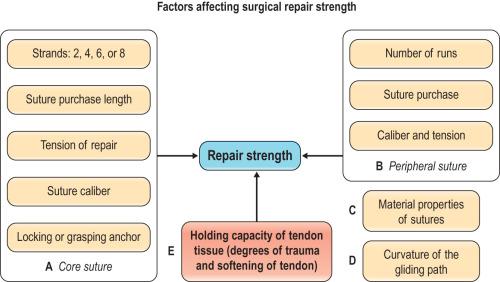
To achieve an optimal surgical repair, the factors outlined above must be considered and incorporated into repair design.
A core suture purchase of at least 0.7–1.0 cm is necessary to generate maximal holding power.
A locking tendon–suture junction is generally better than a grasping junction in terms of holding power ( Fig. 24.8 ) .
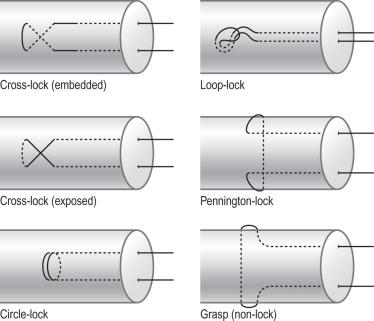
Clinically, the caliber of suture used in adults is either 3–0 or 4–0; sutures of 2–0 or greater are too large and rigid in the hand.
Annular pulleys are critical to the function of the digital flexor tendons. Lengthy loss of the sheath and pulleys causes anterior displacement – bowstringing – of the flexor tendon during finger flexion.
In fingers, the A2 and A4 pulleys are most critically located and functionally important.
Preservation or reconstruction of the two pulleys is necessary in the absence of other pulleys or sheath.
Nevertheless, given the presence of other pulleys and sheaths, the loss of any individual pulleys, including the A2 or A4 pulley, appears to result in few detrimental consequences.
Incision of the A2 pulley up to one-half or two-thirds of its length or of the entire A4 pulley has been shown to result in no tendon bowstringing and little loss of digital flexion.
Flexor tendons in the digits glide in a fairly resistance-free synovial environment. Resistance to tendon motion is increased when the tendons are injured and repaired. The following create resistance to tendon gliding: (1) rough tendon gliding surface; (2) biological reactions of the wound, e.g., subcutaneous and tendon edema; (3) friction caused by exposure of suture materials; (4) increases in tendon bulkiness due to placement of sutures; (5) tight closure of sheath or pulleys that narrows the tendon gliding tunnel; (6) tendon catching at pulley or sheath edges; (7) postsurgical extensor tethering and joint stiffness that burden the movement of the flexor tendon; and (8) adhesions that restrict tendon gliding.
Biological healing strength is a central issue underlying all tendon repairs. After tendon repair, studies have demonstrated that the strength either remained consistent or actually decreased somewhat over the initial few weeks after surgery.
Decreases in strength, typically those in the second postsurgical week, are thought to be caused by softening of the tendon stumps, which lower the sutures’ holding power.
Animal models have demonstrated that the strength of a healing tendon is steady during the initial 4 weeks, followed by a substantial increase (greater than threefold) in the fifth and sixth weeks; thereafter, the tendon heals strongly and is difficult to disrupt.
The fifth and sixth weeks after surgery appear crucial to regaining strength.
Become a Clinical Tree membership for Full access and enjoy Unlimited articles
If you are a member. Log in here